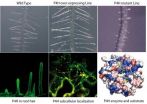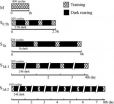(Press-News.org) Fish catches in Madagascar over the last half-century are double the official reports, and much of that fish is being caught by unregulated traditional fishers or accessed cheaply by foreign fishing vessels. Seafood exports from Madagascar often end up in a European recipe, but are a recipe for political unrest at home, where two-thirds of the population face hunger.
These are the findings of a recent study led by researchers from the University of British Columbia's Sea Around Us Project in collaboration with the Madagascar-based conservation organisation Blue Ventures. The research, published online this week in the journal Marine Policy, used existing studies and local knowledge to estimate total fisheries catches between 1950 and 2008.
Link to online version: http://www.sciencedirect.com/science/article/pii/S0308597X11000960
Foreign fishing fleets from Europe and Asia are placing huge pressure on Madagascar's fisheries by catching nearly 80,000 tonnes of seafood each year -- almost the same amount as local fishermen -- and are exacerbating the impact of overfishing at local levels. Consequently, catches of several key species groups seem to be in decline, including mostly exported shrimp, shark and sea cucumber.
The findings underline the importance of protecting local fisheries for food security through stronger fisheries management. Madagascar is the world's fourth largest island and is home to some of the world's poorest people. Two-thirds of the country's population is food insecure. Yet, the country has three monitoring vessels and nine speedboats to protect its waters from illegal fishing boats and monitor domestic fisheries.
"Both increasing pressure by local fishing communities and demand from the international market could accelerate the downward trends we see in Madagascar's fisheries," says Frédéric Le Manach, lead author of the study and a graduate student at the University of Plymouth in the UK and visiting researcher at UBC.
The local shrimp fishery, of prime importance for the national economy, has caught about 12,000 tonnes annually, but is now declining. Most of these shrimp are destined for export to developed countries.
"Securing Madagascar's fisheries for local consumption is of paramount importance to Madagascar's sustainable economic development," says Alasdair Harris, a marine scientist working in Madagascar. The authors suggest that the new data should be considered before allowing foreign fishing vessels further access to Madagascar's waters.
"This study is yet another demonstration of how overfishing impacts humans in different parts of the world," explains supervising author Dirk Zeller and senior research fellow with The Sea Around Us Project at UBC. "In the case of Madagascar, overfishing does not threaten to undermine a nice meal at a restaurant, but one of the mainstays of human survival."
###
The Sea Around Us Project is a scientific collaboration between the University of British Columbia and the Pew Environment Group since 1999.
END
Co-author Professor Tony Bacic from the ARC Centre of Excellence in Plant Cell Walls, School of Botany and the Bio21 Institute, at the University of Melbourne, said plant cell walls (plant biomass) represent the world's largest renewable resource.
"Plant sciences have become a major new driver of international research due to their central role as renewable sources of transport fuels, as functional foods to improve human health, and as a source of raw materials for industrial processes," he said.
The study has been published in the current issue of the international ...
RIKEN and the Japan Synchrotron Radiation Research Institute (JASRI) have successfully produced a first beam of X-ray laser light with a wavelength of 1.2 Angstroms. This light was created using SACLA, a cutting-edge X-ray Free Electron Laser (XFEL) facility unveiled by RIKEN in February 2011 in Harima, Japan. SACLA (SPring-8 Angstrom Compact free electron LAser) opens a window into the structure of atoms and molecules at a level of detail never seen before.
The use of ultra high-intensity X-ray free electron laser light to explore the miniature structure of matter, until ...
The potentially lasting implications of day-to-day couple conflict on physical and mental well-being are revealed in a study published today in the journal Personal Relationships.
Until now research has concentrated on the immediate effects of romantic conflict, typically in controlled laboratory settings. In one of the first studies to look at the longer term, Professor Angela Hicks investigated the physiological and emotional changes taking place in couples the day after conflict occurred, specifically taking into account the differing styles of emotional attachment ...
Luiz Tadeu Moraes Figuedo's paper on dengue in Brazil confirms the country's worsening trend; from 1999-2009, where cases rose at 6.2% per year and dengue deaths at 12.0% per year.
Carmen Perez and co-workers, reporting on dengue vector control in Puerto Rico, found that 83% of the costs ($1.97 per person per year) were funded by the lowest and often the least financed level of government: municipalities.
Examining dengue cases imported into France, Guy LaRuche documented the alarming increase in cases originating from Cote d'Ivoire from only one case in 2006-07 to ...
Negative-pressure wound therapy probably does not promote healing. This is the conclusion of Frank Peinemann and Stefan Sauerland's meta-analysis in the current edition of Deutsches Ärzteblatt International (Dtsch Arztebl Int 2011; 108[22]: 381-9).
In negative-pressure wound therapy (NPWT), wounds are covered with an airtight film and an adjustable negative pressure is applied using an electronically controlled pump. The negative pressure drains wound exudate and is thought to promote healing. This procedure is used in particular for chronic persistent wounds and complicated ...
A University of Exeter biologist has discovered a 'lost' species of bat breeding on the Isles of Scilly (UK). A pregnant female brown long-eared bat is the first of its species to be found on the islands for at least 40 years. It was discovered by Dr Fiona Mathews, Senior Lecturer at the University of Exeter, a postgraduate student and a team from the Wiltshire Bat Group.
The Scilly Isles Bat Group called in Dr Mathews and her team to help them find out more about bats on the islands. The researchers set up a radiotracking study, with funding from the Isles of Scilly ...
Researchers headed by Joan Massagué at Memorial Sloan-Kettering Cancer Center (MSKCC) in New York and by María Macías at the Institute for Research in Biomedicine (IRB Barcelona) have identified a complex mechanism by which some proteins that are essential for life, called Smads, regulate the activity of genes associated with cancer. The fruit of three years of intense work, the study reports on the life cycle of this protein, a process that ensures that the protein is destroyed when it has completed its function. These results have been published today in the top journal ...
Scientists and educators alike have long known that cramming is not an effective way to remember things. With their latest findings, researchers at the RIKEN Brain Science Institute in Japan, studying eye movement response in trained mice, have elucidated the neurological mechanism explaining why this is so. Published in the Journal of Neuroscience, their results suggest that protein synthesis in the cerebellum plays a key role in memory consolidation, shedding light on the fundamental neurological processes governing how we remember.
The "spacing effect", first discovered ...
A compound that for about 60 years has been used as a drug against tapeworm infection is also apparently effective against colon cancer metastasis, as studies using mice have now shown. The compound silences a gene that triggers the formation of metastases in colon cancer. Professor Ulrike Stein (Experimental and Clinical Research Center, a joint cooperation between the Charité Medical Faculty and the Max Delbrück Center for Molecular Medicine, (MDC)) and her research group made this discovery in collaboration with Professor Robert H. Shoemaker of the National Cancer Institute ...
VIDEO:
A movie of the encounter made by combining 100 images of the June 1, 2011 Phobos–Jupiter conjunction. The High Resolution Stereo Camera on Mars Express took this sequence.
Click here for more information.
Earlier this month, ESA's Mars Express performed a special manoeuvre to observe an unusual alignment of Jupiter and the martian moon Phobos. The impressive images have now been processed into a movie of this rare event.
At the moment when Mars Express, Phobos, and ...


